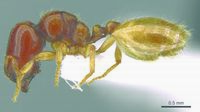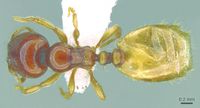Carebara fayrouzae
| Carebara fayrouzae | |
|---|---|

| |
| Scientific classification | |
| Kingdom: | Animalia |
| Phylum: | Arthropoda |
| Class: | Insecta |
| Order: | Hymenoptera |
| Family: | Formicidae |
| Subfamily: | Myrmicinae |
| Tribe: | Crematogastrini |
| Genus: | Carebara |
| Species: | C. fayrouzae |
| Binomial name | |
| Carebara fayrouzae Sharaf, 2013 | |
This new species was found nesting in leaf litter under a large almond tree, Prunus amygdalus Batsch (Rosaceae) in a fenced area of a farm. The soil was composed of two layers, a thin upper clay layer organically enriched where most specimens were found foraging, and a lower thicker layer of loose sand where few specimens were found. Two beetle species were found coexisting with the ants, Oryzaephilus surinamensis (Silvanidae) and Cryptophagus acutangulus (Cryptophagidae). C. fayrouzae is known from desert ecosystems of the central and eastern regions of KSA.
Identification
Sharaf and Aldwood (2013) - Comparative notes. This new species is the second member of the genus recorded from the Arabian Peninsula. According to Fernández (2004), C. fayrouzae belongs to C. lignata species complex with nine antennal segments and unarmed propodeum. It does not resemble any of the American species (Fernández, pers. comm.), or Madagascar species (Azorsa, pers. comm.) and majors are easily distinguished from Carebara arabica of the C. concinna group, by the nine segmented antennae, the absence of cephalic osterolateral teeth and the smooth and shining cephalic dorsum. Superficially, Carebara fayrouzae resembles Carebara afghana (Pisarski, 1970) from Afghanistan in regard to the smooth and shining habitus and the absence of cephalic posterolateral teeth. Carebara fayrouzae can be easily distinguished by the bicoloured major workers, the nine-segmented antennae and the node of postpetiole which is broader than petiolar node in dorsal view. In C. afghana, major workers are concolorous yellow, antennae ten-segmented and node of postpetiole as broad as petiolar node in dorsal view.
At present, two species of Carebara are now known from the Arabian Peninsula, C. arabica of the concinna species complex from the Republic of Yemen and KSA and C. fayrouzae sp. n. of the lignata species complex from KSA.
Major worker
- Smaller species (TL 1.77–2.76); antennae 10-segmented; concolorous brownish, antennae and legs yellowish; posterior margin of head strongly concave and posterior corners with a pair of teeth or horns, appearing blunt in profile; cephalic dorsum dull, with fine, dense, regular and longitudinal rugulae; lateral margins of postpetiole in dorsal view rounded . . . . . Carebara arabica
- Larger species (TL 3.27–5.00); antennae 9-segmented; bicolored, head and mesosoma brownish, petiole and postpetiole brownish yellow, antennae, legs and gaster clear yellowish; posterior margin of head feebly concave and posterior corners rounded, without teeth or horns; cephalic dorsum smooth and shining except anterior part of head finely, longitudinally rugulose; lateral margins of postpetiole distinctly angular in dorsal view . . . . . Carebara fayrouzae
Minor worker
- Antennae 10-segmented; eyes minute, with a single ommatidium (present in all individuals); body pilosity subdecumbent or appressed and much scarce; anterolateral sides of head very finely longitudinally striated; lower halves of mesopleuron, metapleuron, petiole and postpetiole areolate-rugose; propodeal dorsum nearly half as long as propodeal declivity in profile. . . . . . Carebara arabica
- Antennae 9-segmented; eyes as rudimentary ommatidium (absent in some individuals); body pilosity erect to suberect and dense; entire body smooth without any type of surface sculpture; propodeal dorsum as long as declivity, appearing as a continuous curve in profile . . . . . Carebara fayrouzae
Distribution
Latitudinal Distribution Pattern
Latitudinal Range: 26.51028° to 24.38931°.
| North Temperate |
North Subtropical |
Tropical | South Subtropical |
South Temperate |
- Source: AntMaps
Distribution based on Regional Taxon Lists
Afrotropical Region: Saudi Arabia (type locality).
Distribution based on AntMaps
Distribution based on AntWeb specimens
Check data from AntWeb
Countries Occupied
| Number of countries occupied by this species based on AntWiki Regional Taxon Lists. In general, fewer countries occupied indicates a narrower range, while more countries indicates a more widespread species. |

|
Estimated Abundance
| Relative abundance based on number of AntMaps records per species (this species within the purple bar). Fewer records (to the left) indicates a less abundant/encountered species while more records (to the right) indicates more abundant/encountered species. |

|
Biology
Castes
Worker
Minor
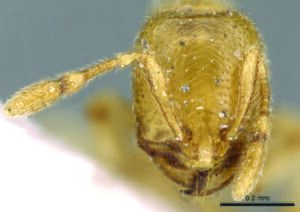 
| |
| . | |
Queen
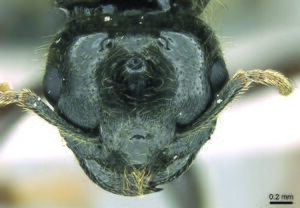 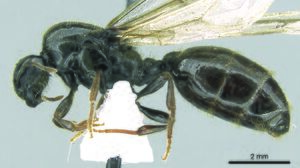 
| |
| . | |
Nomenclature
The following information is derived from Barry Bolton's Online Catalogue of the Ants of the World.
- fayrouzae. Carebara fayrouzae Sharaf, in Sharaf & Aldawood, 2013b: 75, figs. 7-15 (s.w.q.) SAUDI ARABIA.
- Type-material: holotype major worker, 16 paratype major workers, 38 paratype minor workers, 4 paratype queens.
- Type-locality: holotype Saudi Arabia: Eastern Prov., Al Qatif, El Naft, 26.51028°N, 49.96889°E, 30 m., 23.iii.2012 (M.R. Sharaf); paratypes: 16 major workers, 28 minor workers, 4 queens with same data, 2 minor workers Saudi Arabia: Riyadh, Alhaeir, 24.iii.2009 (Acarology Lab. Team), 4 minor workers Riyadh, iii.1989 (no collector’s name), 2 minor workers N Riyadh, Ammaryia, 5.iii.2010, 681 m. (Acarology Lab. Team), 1 minor worker Riyadh, Mezahmia, Rawdat Kharara, 712 m., 30.i.2011 (M.R. Sharaf).
- Type-depositories: KSMA (holotype); BMNH, CASC, KSMA, MCZC, MHNG, NHMB, UKLK, WMLC (paratypes).
- [Misspelled as faurouzae by Borowiec, L. 2014: 50.]
- Status as species: Borowiec, L. 2014: 50.
- Distribution: Saudi Arabia.
Unless otherwise noted the text for the remainder of this section is reported from the publication that includes the original description.
Description
Worker
Holotype major. TL 3.62, HL 1.10, HW 0.72, SL 0.37, EL 0.05, ML 0.87, PRW 0.50, PL0.20, PW 0.25, PPL 0.20, PPW 0.27, SI 51, CI 65.
Paratype majors. TL 3.27–5.00, HL 1.00–1.20, HW 0.72–0.87, SL 0.32–0.42, EL 0.05, ML0.85–1.12, PRW 0.50–0.60, PL 0.20–0.27, PW 0.22–0.30, PPL 0.20–0.27, PPW 0.27–0.40, SI 38–53, CI 65–78 (N=15).
Major Head longer than broad (HL = 1.5 × HW), with feebly concave posterior margin, rounded posterior corners and parallel sides; masticatory margin of mandibles armed with four teeth; antennae nine-segmented; antennal scapes very short; clypeus narrow and with weakly concave anterior margin; eyes very tiny (in some individuals eyes absent); ocelli absent. Mesosoma in profile with distinct promesonotal suture; promesonotum feebly concave; metanotum small and narrow; dorsal face of propodeum continuously sloping and curving into declivity without spine or angle. Petiole in dorsal view little broader than long; petiolar peduncle short; petiolar ventral process distinct. Postpetiole in dorsal view nearly twice as broad as long, with acute lateral angles. Postpetiole in profile with distinct ventral process. Sculpture: Body smooth and glossy, anterior part of head finely, longitudinally rugulose, area between meso- and metapleura finely cross-ribbed. Pilosity: Head dorsum with scattered short hairs, rest of body with longer dense, yellow hairs. Colour: Bicolored species, head and mesosoma brownish, petiole and postpetiole brownish yellow, antennae, legs and gaster clear yellow.
Paratype minors. TL 1.66–1.94, HL 0.44–0.51, HW 0.29–0.44, SL 0.25–0.31, EL 0.007, ML0.49–0.53, PRW 0.22–0.31, PL 0.09–0.17, PW 0.09–0.14, PPL 0.07–0.09, PPW 0.09–0.12, SI 59–79, CI 78–100 (N=15).
Minor Head distinctly longer than broad, with straight posterior margin and parallel sides; masticatory margin of mandibles armed with four teeth; antennae nine-segmented; scapes when laid back from their insertions fail to reach posterior margin of head by about one third of head width; anterior clypeal margin nearly straight; eyes with only one ommatidium (absent in some individuals). Mesosoma nearly flat in profile; promesonotal suture indistinct; metanotal groove distinct; propodeal dorsum meeting declivity in a continuous curve; propodeal spiracle in profile high and located above midline of propodeum. Petiole in profile shortly pedunculate, with blunt ventral process and in dorsal view slightly longer than broad. Node of postpetiole in dorsal view clearly broader than long and in profile distinctly lower than petiolar node. Colour: Unicolorous clear yellow, hairy, smooth and moderately shining.
Queen
Paratypes. TL 9.75–10.75, HL 1.10–1.35, HW 1.45–1.50, SL 0.60–0.90, EL 0.35-0.45, ML3.25–3.50, PL 0.50–0.75, PW 0.65–0.70, PPL 0.50–0.60, PPW 0.85–1.00, SI 40–62, CI 107–136 (N=3).
Body enormous, notably larger than minor and major workers. Head triangular, broader than long (HW = 1.2 × HL), with straight posterior margin and strongly convex lateral margins; masticatory margin of mandibles armed with four teeth; antennae nine-segmented; antennal scapes when laid back from their insertions reach level of posterior margin of eyes; anterior clypeal margin convex, eyes large and multifaceted (about 0.27 × HW); ocelli present. Mesosoma robust, pronotum not exposed above, lying entirely beneath the mesonotum; propodeum unarmed; remaining characters modified as in myrmicine queens. Petiole in dorsal view longer than broad. Postpetiole very broadly attached to gaster and node in dorsal view distinctly broader than long. Sculpture: Anterior half of cephalic dorsum with fine longitudinal striations extend to before posterior level of eyes; median portion of clypeus, posterior half of head, mesosoma and gaster smooth and shining, petiole and postpetiole superficially and finely shagreenate. Pilosity: Whole body covered with abundant, long, yellow hairs. Colour: Uniformly black, funiculi, tibiae and tarsi blackish brown.
Type Material
Holotype major worker. SAUDI ARABIA, Al Qatif, El Naft, Eastern Province, 26.51028°N, 49.96889°E, 30 m. 23.iii.2012 (M. R. Sharaf Leg.) (MRS0066); King Saud University Museum of Arthropods (KSMA), College of Food and Agriculture Sciences, King Saud University, Riyadh, KSA.
Paratypes. 28 minor workers (CASENT0280994), 16 major workers (CASENT0280975), 4 queens (CASENT0906362) with same locality and data as the holotype (KSMA); a single paratype specimen of minor and major workers, and queen are deposited in Musee d'Histoire Naturelle Genève; Naturhistorisches Museum, Basel; California Academy of Sciences; Museum of Comparative Zoology; SEMC; WMLC; The Natural History Museum; 2 minor workers, SAUDI ARABIA, Riyadh, Alhaeir, 24.59214°N, 46.74522°E, 24.iii.2009, lemon soil, Berlese funnel (Acarology lab team at Department of Plant Protection, KSU Leg.); 4 minor workers, SAUDI ARABIA, Riyadh, iii.1989, Soil fauna (no collector data); 2 minor workers, SAUDI ARABIA, N. Riyadh, Ammaryia, 5.iii.2010, 24.806402°N, 46.428845°E, 681m, Lettuce soil fauna, Berlese funnel (Acarology lab team at Department of Plant Protection, KSU Leg.) These paratypes are in KSMA; 1 minor worker, SAUDI ARABIA, Riyadh, Mezahmia, Rawdat Kharara, 24.38931°N, 46.24211°E, 712 m. 30.i.2011, (M. R. Sharaf Leg.) (CASC); 1 minor worker, SAUDI ARABIA, Riyadh, Al Rowayda, 25.88016°N,45.11563°E, 22.ii.2009, (M. R. Sharaf Leg.) (CASC) (All are paratypes).
Etymology
This new species is dedicated to Fayrouz Sharaf (the daughter of the senior author).
References
References based on Global Ant Biodiversity Informatics
- Sharaf M. R., and S. A. Aldawood. 2013. The ant genus Carebara Westwood in the Arabian Peninsula (Hymenoptera, Formicidae). ZooKeys 357: 67-83.
